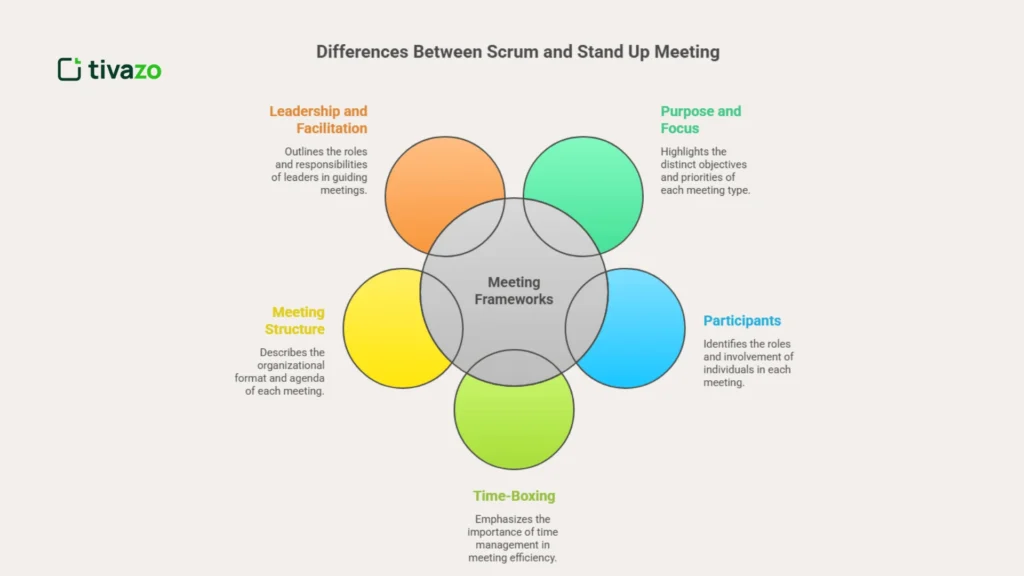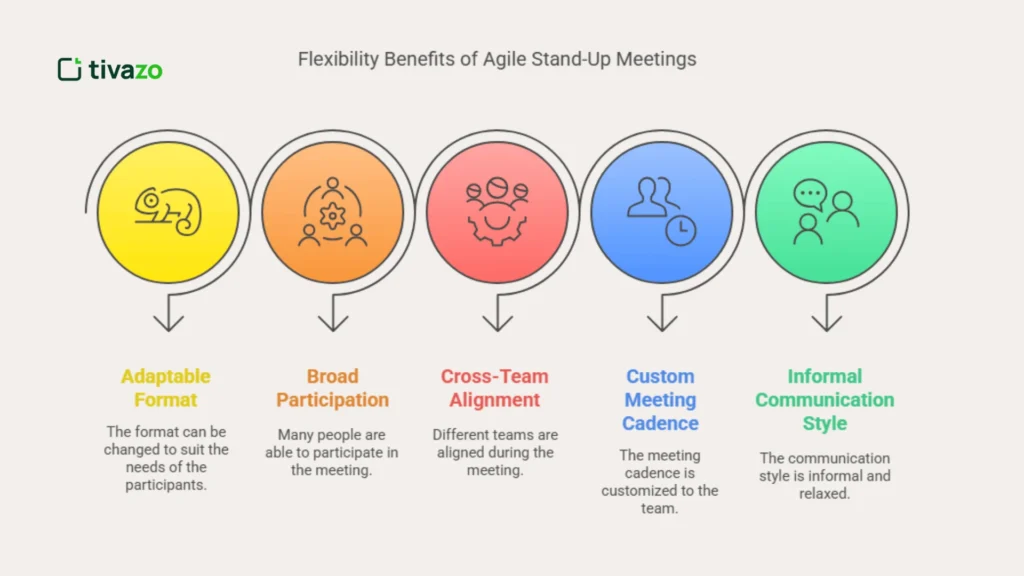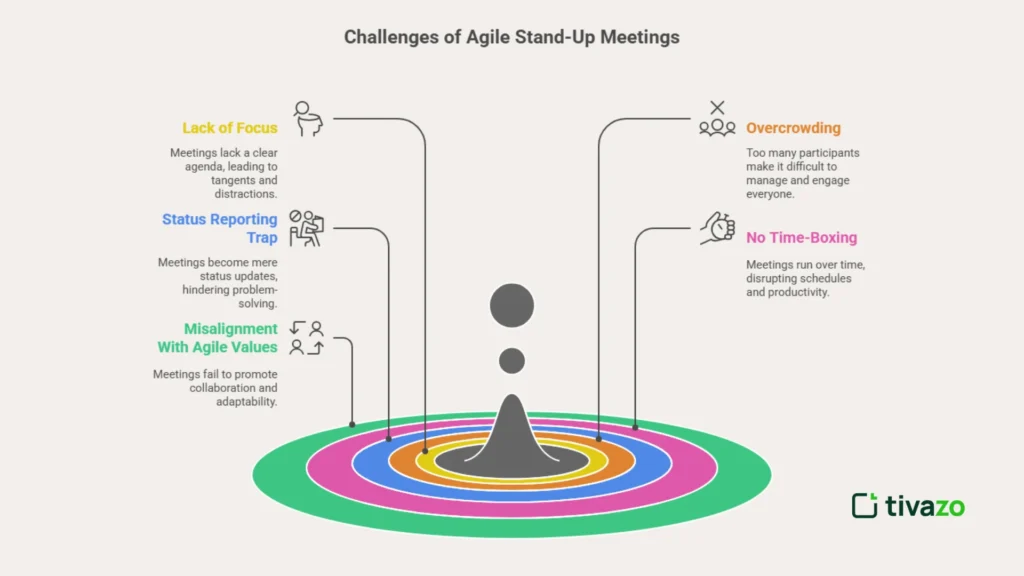Agile teams are necessary to meet daily, yet not all the daily check-ins are the same. Most people interchange the roles between Scrum vs Stand up although they never realize their individual functions.
These two meetings encourage collaboration within teams in agile and improve communication in scrum teams, but the daily scrum is a rigid, time-bound occasion that aims at the objectives of a sprint. Conversely, a stand up meeting is sometimes an informal status check. An understanding of differences can enhance the alignment and work delivery of your team.
Recognizing the enormous difference between scrum vs stand up meetings enables the agile teams to remain focused on adding value to the organization. This paper discusses their distinctive features and goals, attendees, and templates, in addition to providing advice to make these rituals as effective for the development team and improvement tracking in agile constructs as possible.
What is a Stand-Up meeting?
A stand-up meeting is a short, unstructured session that agile project management applies to enhance collaboration within the team in an agile setting. In contrast to the well-organized scrum every day, stand-up meetings typically involve more people, such as developers, testers, managers, and stakeholders, who exchange brief status reports. Damage control: These meetings are preoccupied with the state of progress in agile projects and dealing with present blockers, though these are less formal and looser in both format and timing. Although beneficial with regard to communication, stand-ups are not as time-boxed and goal-oriented as Scrum ceremonies.
What is Daily Scrum?
The Daily Scrum is a key Scrum ceremony and a time-boxed, 15-minute meeting held every workday for the development team. Its primary goal is to enhance communication in scrum teams, synchronize work, and enable effective progress tracking in agile projects. Unlike a typical stand-up meeting, the Daily Scrum focuses on inspecting progress toward the sprint goal, identifying blockers, and adapting plans collaboratively. Facilitated by the Scrum Master, it strictly follows the Scrum meeting format to promote discipline and alignment within the team.
5 Key Differences Between Scrum and Stand Up: Core Comparison
It is crucial to learn the distinction between Scrum and stand-up to hold successful agile meetings. As much as they may both be used to meet day-to-day communication requirements, the uses, formats, and users are also quite different.

These are the five main differences reflecting how each meeting will be incorporated into the workflow of agile software development to help your team select the optimal one and contribute to more efficient work of a team in agile and an easier tracking of progress in an agile project.
1. Purpose and Focus
The main idea behind the Daily Scrum is to orient the members of the development team towards the sprint goal. It is a strategic gathering where members of the team monitor the progress make plans on what should be done during the day, and determine any constraints that may hinder speedy delivery. It is a close model that keeps the entire team working towards the same goal so that the sprint does not lose its way.
Example: A software team may use the Daily Scrum to decide in less than 10 minutes that a very severe bug prevented one of its developers yesterday and that this is a priority today to finish the sprint on time.
Tip: Team members should be encouraged to talk in relation to the sprint goals, not to individual tasks, so as to keep their eye on the common goal.
Conversely, the stand-up meeting is more of a general meeting on the status of a larger group. It is more of giving what everyone is doing instead of being specific about the sprint goals or modification of the working plan. This can be useful in cross-team knowledge but does not necessarily have the accuracy required in Agile development cycles.
Tip: Battles: looking to take longer than status reports? Maybe you can assign a good old agenda or time constraints to keep your stand-ups on track.
Due to this variation, the former (Daily Scrum) motivates work and around-the-minute problem-solving, but stand-ups may also turn out to become the daily calls that lack explicit results. This difference is good to know because it allows the teams to remain concise and efficient in their everyday communication.
2. Participants
Fewer attendees are one of the greatest differences between Scrum and stand-up meetings. The development team is restricted to the Daily Scrum, and the Scrum Master leads this ceremony, whereas the product owner is an optional observer. This intimate group makes the discussion technical and delivery-oriented.
Example: On a normal Daily Scrum, developers only talk about technical blockers or modifications on the task priorities, and there are no managers who take control and switch the topic.
Tip: Ensure Daily Scrum meetings are limited to the number of people working on the current sprint to guard against meeting hijacks and guard team control.
However, stand-up meetings are usually characterized by a greater range of audiences, including testers, business analysts, managers, and in some cases, stakeholders. Although this inclusivity facilitates transparency to a greater depth of the departments, distractions may be created or the meeting may take longer and stray from the point of development.
Tip: In the case of cross-functional stand-ups, you should be very clear in terms of what type of updates you require to prevent talking too long.
To ensure that a safe environment exists within the scrum team of candid interaction, fast-decision making, and clarity in communication, it is recommended that the Daily Scrum remains an affair of the development team only. The approach is most useful in teams that seek more focused and quicker syncs.
3. Time-Boxing
The most important idea of Agile is called time-boxing, and the Daily Scrum is a good example of such time-boxing with only a 15-minute limit. This encourages updates to be succinct, blockers to be known fast, and next steps to be known immediately without prolonging the meeting. The brief, regular length assists the creation of a day-by-day rhythm and honors the time of any individual in it.
Example: A team may have a timer on their Daily Scrum, so that no one would take more than their allocation of speaking time, and the meeting would remain effective.
Tip: Have visual reminders to keep everyone in check, especially when it comes to time during stand-ups or scrums.
In comparison with stand-up meetings, however, this rigidity of time-boxing may not be as pronounced, and instead, the stand-up meetings may take longer, particularly when employees belong to various functions or levels of the organization. Lacking distinct boundaries, such meetings run the risk of being inefficient status reports as opposed to goal-oriented meetings.
Tip: Make sure that your stand-ups do not take longer than 15 minutes on a regular basis. Otherwise, smaller groups or implementing stricter facilitation is a recommendation.
The strict approach to time-boxing in Daily Scrum helps to have better progress tracking in agile projects as discussions are kept topical and solution-oriented. Stand-ups may carry over into precious development time even with the team’s permission.
4. Meeting Structure
The Daily Scrum is a structured meeting that bases its rules on the Scrum theory and practice. Even though the three original questions of the traditional questioning formula of yesterday pan out in words of three types of objects, what did you do yesterday? What today? The actual blocking question, such as muring Are there any blockers?”) It is not about obstacles to the final goal, but instead about making adjustments in an attempt to jointly follow the sprint goal. The structure motivates the element of accountability and ensures that the team remains on the same path.
Example: At the end of the daily meeting, a Scrum team resolves to assign a team member to assist another one to unblock their progress in the daily meeting, making an action-oriented meeting.
Tip: Do not strictly stick to the three questions; instead, persuade teams to talk about the effect that their work has on sprint objectives to create a sense of cooperation.
Stand-up meetings are less formal, and they tend to be in the form of those three common questions. Although this structure is suitable for providing rapid updates, it might not foster the reflective thinking or learned planning that is observed in Scrum ceremonies. The stand-ups easily run into a risk of becoming tedious and less productive without a clearly defined goal.
Tip: Let stand-ups be followed by retrospectives of five to ten minutes, which should be introduced regularly to make the meetings effective and engaging.
A specific structure of scrum meetings guarantees that the meetings are more than habitual, or rather, have a purpose. This structure helps teams to be more aligned, to resolve their problems quicker, and to deliver better.
5. Leadership and Facilitation
The Scrum Master is facilitative in Scrum, and the Daily Scrum is no exception; the Scrum Master does not dictate the discussion or point the conversation in a direction; rather, he/she ensures that the team complies with the time box and the agenda. This helps the development team self-organize, own, and share problem resolution.
Example: When running a Daily Scrum, the Scrum Master supports the team by ensuring that people are talking about the real subject and ensuring that time is kept without losing control or taking the lead in a debate.
Tip: Grant your Scrum Master the freedom to coach other people but not to control them, and encourage team independence and responsibility.
In comparison, stand-up meetings are usually chaired by managers or team leads, but they might direct the meeting or be used to report. Although this may create leadership control, it at times transforms the work aspect of collaboration to status reporting, thereby interfering with team autonomy.
Tip: Managers who run stand-ups should have a coaching mentality where they do not question what is going on as a status check, but rather what the problem is and how it can be solved.
Such a situation enables the team to facilitate the Daily Scrum itself on their own, and encourages participation and responsibility, which are the ingredients of agile success. Other teams where the stand-ups are manager-led may realize that there is reduced communication and that the issues are slower to be resolved.
Comparison Table of Scrum vs Stand up
| Aspect | Daily Scrum | Stand Up Meeting |
| Purpose and Focus | Align the development team on the sprint goal, inspect progress, and remove blockers. Focused on sprint delivery and progress tracking in agile. | General status updates for a broader group; less focused on sprint goals, more on overall team collaboration in agile. |
| Participants | Development team only, with Scrum Master facilitating; Product Owner may observe. | Cross-functional: developers, testers, managers, stakeholders, and others. |
| Time-Boxing | Strictly 15 minutes, daily at the same time and place for consistency. | Variable length and frequency; may run longer without strict limits. |
| Meeting Structure | Formal scrum meeting format; focused on sprint goals, blockers, and adaptive planning. | Less structured; often follows the traditional three questions, but can lack goal orientation. |
| Leadership and Facilitation | Scrum Master facilitates without leading; the team self-organizes and owns the meeting. | Usually led by managers or team leads, it can shift to status reporting rather than collaboration. |
Daily Stand Up vs Scrum Meeting: Who Should Attend?
Understanding the right attendees helps maximize meeting value.
- Daily Scrum: Exclusively the development team, possibly with the Scrum Master and Product Owner as listeners.
- Stand up: Cross-functional team members, including QA, business analysts, project managers, and sometimes senior leadership.
This difference matters because the daily scrum empowers developers to self-manage and address blockers directly. The stand-up meeting may become a status-reporting session if not managed carefully.
Scrum Meeting Format: How Daily Scrum Works
The scrum meeting format is designed to foster quick, focused communication aligned with Agile principles:
- Held at the same time and place daily.
- Lasts 15 minutes, no longer.
- Developers discuss progress toward the sprint goal.
- Blockers are raised and assigned for resolution.
- No problem-solving occurs in the meeting itself; follow-ups happen afterward.
According to Agile Alliance research, teams that rigorously follow the Scrum format report up to 20% higher sprint success rates due to enhanced clarity and quick risk mitigation.
Agile Stand Up Meeting: Flexibility and Challenges
The stand-up meetings, as performed in Agile, are an all-time favorite when it comes time to align teams, even in an environment where the use of Scrum is not purely adhered to. They are flexible and designed in such a way that they can fit different workflows, but at the same time, they may be inconsistent and confusing.
Being aware of how to navigate stand-ups and their possible pitfalls can allow your team to enjoy all the advantages of agile stand-up meetings and avoid typical pitfalls.
Flexibility of Agile Stand-Up Meetings

1. Adaptable Format
Stand-ups enable teams to conduct the discussion according to the work progress compared to the static format of the scrum meeting. The format can be changed to meet the needs of teams without any rigid regulations, regardless of whether you are using Scrum, Kanban, or a combination of both.
2. Broad Participation
Not only is the development team eligible for the stand-up meetings. They can be joined by testers, project managers, analysts, and even by the stakeholders, which makes them very helpful in agile team collaboration that requires collaboration across multiple functions.
3. Cross-Team Alignment
With the bigger projects or cross-functional projects, stand-ups become the grounds of synchronization across departments. They assist in revealing dependencies and maintaining cross-team communication between teams that do not communicate with each other every day.
4. Custom Meeting Cadence
Stand-ups are a daily activity in some teams, and in other teams, only a few times a week. The Ergonomics feature of agile teams helps the team cut on unwarranted overheads and get into the rhythm of work.
5. Informal Communication Style
Stand-ups present an informal environment in which updates can be made, which means less pressure and the surrounding environment is friendlier to allow team members to talk. Such a free form accommodates higher levels of transparency and can aid communication within the scrum teams, particularly in instances when psychological safety is low.
Challenges of Agile Stand-Up Meetings

1. Lack of Focus
Stand-ups can go off on a tangent without a definite structure. There is an unnecessary loss of value and time wastage in meetings, which eventually has an effect on tracking progress in agile projects when dealing with too many irrelevant updates.
2. Overcrowding
Having many people involved in stand-ups can also make them unnecessarily loud, distracted, or long. The larger the audience is, the more difficult it is to maintain the discussion on topic and efficiently for all parties concerned.
3. Status Reporting Trap
There are situations when stand-ups transform into a report to a manager instead of being a team discussion. This transition may damage the development unit’s acculturation and diminish work ownership.
4. No Time-Boxing
In stand-ups, strict time-boxing is usually not followed, like the case in the Daily Scrum. The result is developer meetings that run late, interfere with deep work, or induce meeting fatigue, particularly in high-stress situations.
5. Misalignment With Agile Values
Stand-ups can be shown but not performed when not done well. In their absence, they turn out to be mere meetings with an insignificant relation to actual team performance.
Conclusion
Understanding the real difference between Scrum vs stand up is critical for agile teams aiming to improve communication and delivery. While both serve daily coordination needs, the daily scrum brings structure, clear sprint goals, and disciplined progress tracking in agile. In contrast, agile stand up meetings offer flexibility and broader participation but risk losing focus without the right format.
Choosing the right meeting, based on your team’s goals, structure, and maturity, can enhance team collaboration in agile environments and drive better outcomes. Use these insights to fine-tune your ceremonies and strengthen your agile project management practices.
FAQ’s
Why is the daily scrum meeting called a stand-up?
It’s called a stand-up to encourage brevity—standing helps keep the meeting short and focused. While all Daily Scrums are stand-ups, not all stand-ups follow the Scrum format.
What is a stand-up in agile?
A stand-up in agile is a quick daily meeting where team members share progress, plans, and blockers. It helps maintain team collaboration and keeps everyone aligned on goals.
What is the difference between Agile and Scrum?
Agile is a broad methodology based on values and principles for iterative development. Scrum is a specific Agile framework with defined roles, ceremonies, and practices like the Daily Scrum.




